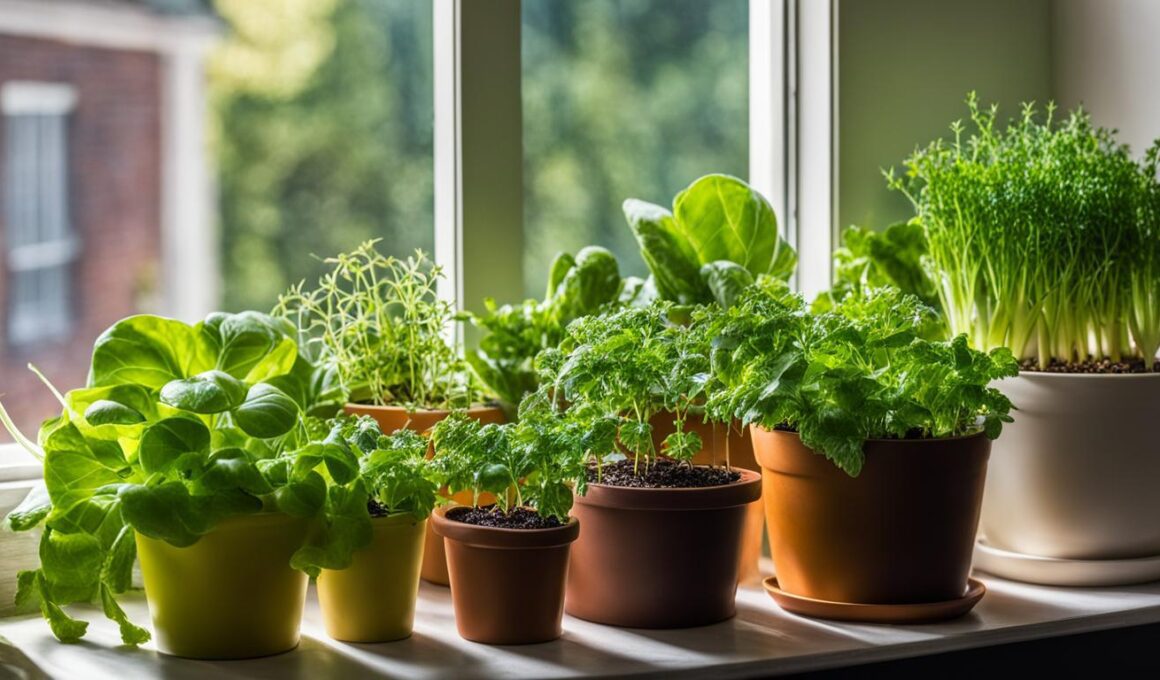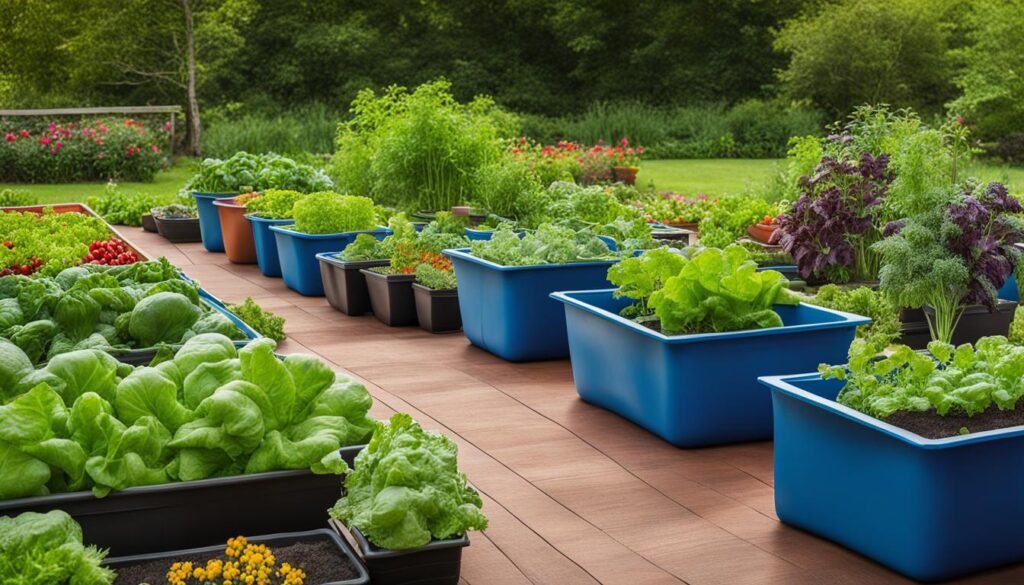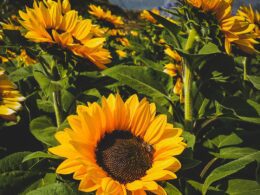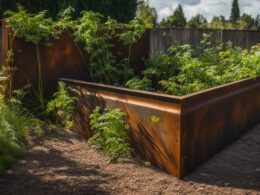Welcome to our easy guide on growing vegetables in pots for beginners. Whether you have limited outdoor space or simply want to try your hand at gardening, container gardening is a fantastic option. In this guide, we will provide you with the essential tips and information you need to successfully grow vegetables in pots and create a thriving home garden.
Container gardening offers numerous benefits, including the ability to control growing conditions and maximize available space. Even if you are new to gardening, with the right techniques and proper care, you can enjoy the satisfaction of growing your own fresh produce right at home.
Key Takeaways:
- Choosing the right container size for each vegetable is crucial
- Peas and lettuce are great options for beginners due to their fast growth
- Ensure your plants get at least 6 hours of direct sunlight each day
- Use high-quality potting soil, provide sufficient water, and add fertilizer or compost for nutrients
- Proper drainage is essential to prevent root rot
Benefits of Growing Vegetables in Containers
Growing vegetables in containers offers a multitude of benefits, making it an ideal choice for gardening enthusiasts, especially those with limited yard space. Whether you live in an apartment, have a small patio, or simply want to make the most of your available space, container gardening allows you to cultivate your own fresh produce right at home.
One of the main advantages of container gardening is the level of control it offers over growing conditions. You have the freedom to choose the type of soil, provide specific amounts of nutrients, and ensure optimal water accessibility for your plants. This control not only promotes healthier growth but also allows for customization according to the specific needs of each vegetable.
Container gardening also reduces the likelihood of weed growth, making maintenance easier and keeping your vegetable garden clean and tidy. Additionally, harvesting becomes a breeze as everything is conveniently contained in pots or containers, eliminating the need to navigate through sprawling garden beds.
Container gardening is an excellent starting point for beginners, enabling them to start small and gain valuable gardening experience before venturing into larger-scale gardens. With containers, you have the opportunity to experiment and learn, developing your gardening skills along the way.
Whether you’re growing vegetables from seeds or opting for seedlings, container gardening allows you to select plants that are specifically suited for this type of cultivation. Additionally, by choosing bush or small varieties of vegetables, you increase the likelihood of success in your container garden. Peas, lettuce, tomatoes, and peppers are all excellent choices for beginners as they are quick-growing and adapt well to container environments.
The Advantages Summarized:
- Optimal use of limited yard space
- Greater control over growing conditions
- Reduction in weed growth
- Easier and cleaner harvesting
- Perfect starting point for beginners
- Ability to grow suitable varieties for containers
Choosing the Right Containers for Vegetable Gardening
When it comes to container gardening, selecting the right containers is crucial for the successful growth of your vegetables. Consider the size and material of the pots to ensure that your plants have enough space to thrive.
If you’re planning to grow larger vegetables like tomatoes or peppers, opt for containers that offer ample root space. On the other hand, shallow-rooted plants like lettuce can thrive in smaller pots. Keep in mind that wooden containers may rot over time, so you might need to replace them eventually. Self-watering containers are a popular choice as they provide consistent moisture to the plants without the need for frequent watering.
There are various container materials to choose from, including food-grade plastic, glazed ceramic, and terra cotta pots. Each material has its own advantages and considerations. For instance, plastic pots are lightweight and affordable, while ceramic pots add aesthetic appeal to your garden. Whichever material you choose, make sure to prevent the soil from drying out too quickly.
Don’t feel limited to traditional pots and containers either. Upcycled items like plastic buckets or kitchenware can work just as well as expensive options. The key is to ensure that the containers have proper drainage holes and are suitable for the specific needs of your vegetables.
Benefits of Choosing the Right Containers:
- Provides adequate root space for optimal plant growth
- Helps prevent rotting or drying out of the soil
- Offers convenience with self-watering options
- Enhances the aesthetic appeal of your container garden
- Allows for creativity and upcycling with alternative container choices
“Choosing the right containers for vegetable gardening is crucial for the success of your plants. Consider the size, material, and drainage options to provide the ideal growing environment for your vegetables.”
By carefully selecting the right containers for your vegetable garden, you can provide the best growing conditions for your plants. Remember to consider the specific needs of each vegetable and choose containers that align with those requirements. With the right containers, your vegetable garden will thrive and provide you with a bountiful harvest.
Selecting the Right Soil for Container Gardening
Growing vegetables in pots requires careful consideration of the soil you use. The right soil is crucial for providing nutrients and proper drainage to your plants. Here are some factors to consider when choosing soil for your container garden:
- Drainage: Look for a potting mix that provides good drainage to prevent waterlogged roots. Excess moisture can lead to root rot and other plant diseases.
- Nutrients: Opt for a potting mix that is rich in organic matter and nutrients. This will ensure that your plants have access to the essential elements they need for healthy growth.
- Texture: Choose a potting mix with a light and airy texture. This will help with water retention and root aeration, allowing your plants to thrive.
It’s important to note that garden soil is not suitable for container gardening. Garden soil can become compacted and may not provide adequate drainage for potted plants. Instead, use a potting mix specifically formulated for containers.
“Using high-quality potting soil is essential for successful container gardening. Potting mixes provide the right balance of drainage, nutrients, and texture for optimal plant growth.” – Gardening Expert
Consider adding compost or organic fertilizer to your potting mix throughout the growing season. This will further enrich the soil and provide ongoing nourishment for your plants. Remember to follow the specific instructions on the fertilizer packaging to avoid overfeeding your plants.
Proper Watering Techniques for Container Gardening
When it comes to growing vegetables in pots, proper watering is essential for the health and success of your container garden. Container plants tend to dry out more quickly than those grown in the ground, so it’s important to establish a consistent watering routine.
One of the best practices for watering vegetables in pots is to water in the morning. This allows the plants to absorb the moisture they need to withstand the hot midday hours. Watering deeply is key to ensuring that water reaches the roots. Aim to saturate the soil until you see water draining out of the bottom of the pot. This ensures that the water reaches the deeper roots of your plants.
It’s important to avoid overwatering your container garden as it can lead to root rot and other issues. Before watering again, check the moisture level of the soil by sticking your finger about an inch deep into the soil. If it feels dry at that depth, it’s time to water again. However, if it still feels slightly moist, hold off on watering for a little longer.
Tips for Effective Watering in Container Gardening:
- Water your container garden in the morning to provide plants with moisture to withstand the heat of the day.
- Water deeply to ensure that water reaches the roots.
- Check the moisture level of the soil before watering again to avoid overwatering.
- During the peak of summer or hot weather, container gardens may require daily watering.
By following these watering tips, you can help your vegetables thrive in containers and achieve a successful harvest.
Essential Tips for Successful Vegetable Container Gardening
If you’re new to vegetable container gardening, these essential tips will help you get started on the right foot:
- Choose the right location: Place your containers in an area that receives at least 6 hours of sunlight each day. Fruiting vegetables like tomatoes and peppers need full sun, while leafy greens can tolerate partial shade.
- Proper watering: Container plants tend to dry out quickly, so it’s important to water them regularly. Water deeply until it drains out from the bottom of the pot, and avoid overwatering by checking the moisture level of the soil before watering again.
- Use high-quality potting soil: Opt for a well-draining potting mix specifically formulated for container gardening. Avoid using garden soil, as it can become compacted and hinder water drainage.
- Fertilize regularly: Container-grown vegetables require regular feeding. Use a balanced fertilizer or organic compost to supply essential nutrients for healthy growth.
- Choose the right container size: Different vegetables have different root space requirements. Ensure your containers are large enough to accommodate the mature size of the plants.
- Provide wind protection: Strong winds can dry out the soil and cause containers to topple over. Consider placing your containers in a sheltered area or using windbreaks to protect them.
By following these tips, you’ll increase your chances of success in your vegetable container gardening endeavors. Remember to choose suitable vegetables for container gardening, provide proper care, and enjoy the satisfaction of harvesting your own fresh produce!
Inexpensive Container Gardening Options for Beginners
If you’re a beginner looking to dip your toes into container gardening, there’s no need to break the bank. There are plenty of affordable options that can still yield fruitful results. Take a look at these inexpensive container gardening ideas that can help you get started on your gardening journey without spending a fortune.
“Upcycled containers like large coffee cans, milk jugs, and kitchenware can be suitable for growing small crops.” – Container gardening doesn’t have to mean buying brand new pots. Repurposing household items like coffee cans and milk jugs can provide a cost-effective solution. Plus, it’s a great way to reduce waste and give these items a second life in your garden.
Another budget-friendly option is using free or inexpensive plastic buckets from local stores or nursery pots. These containers are often readily available and can be easily repurposed for gardening purposes. Don’t be afraid to get creative and think outside the box when it comes to choosing containers for your vegetable garden.
- Upcycled containers like coffee cans and milk jugs
- Free or inexpensive plastic buckets
- Repurposed kitchenware
Lastly, consider fabric pots and glazed ceramic containers. While they may be slightly pricier than other options, they offer durability and visual appeal. These containers can be reused year after year, making them a worthwhile investment for your container gardening endeavors.
Remember, when it comes to container gardening, you don’t have to spend a fortune to enjoy the benefits of growing your own vegetables. With some creativity and resourcefulness, you can create an affordable and productive garden right in your own backyard.
Conclusion
In summary, growing vegetables in pots is a fantastic option for beginners who want to start their own home gardens. With the right techniques and knowledge, you can successfully grow your own fresh produce even in limited spaces. Container gardening offers a range of benefits, including the ability to control growing conditions and maximize available space.
By choosing the appropriate containers and soil, providing proper watering and care, and selecting suitable vegetables, you can enjoy the satisfaction of harvesting your own homegrown vegetables. Whether you opt for upcycled containers, affordable plastic buckets, or more durable options like glazed ceramic containers, there are plenty of choices to suit your needs and budget.
So why wait? Get started with container gardening today and experience the joy of growing your own vegetables. Not only will you have access to fresh, nutritious produce, but you’ll also develop new skills and enjoy the beauty of nurturing plants. Whether you have a small balcony or a spacious backyard, container gardening can transform any space into a bountiful garden.
Can the same potting soil and techniques used for growing tomatoes be applied to other vegetables in pots?
Yes, the same potting soil and techniques used for growing tomatoes can be applied to other vegetables in pots. For a complete tutorial growing tomatoes, you can also use the same principles for peppers, zucchinis, and herbs. The key is to ensure proper drainage, sunlight, and regular fertilization for successful growth.
FAQ
Can I grow vegetables in pots if I’m a beginner?
Absolutely! Container gardening is a great option for beginners as it allows you to start small and gain gardening experience before moving on to larger gardens.
What are the benefits of growing vegetables in containers?
Container gardening offers several benefits, including maximizing limited yard space, overcoming poor soil conditions, reducing weeds, and making harvesting easier and cleaner.
How do I choose the right containers for vegetable gardening?
When choosing containers, consider the size and material. Larger vegetables require containers with more root space, while shallow-rooted plants like lettuce can thrive in smaller pots. Wooden containers are aesthetically pleasing but may rot over time, while self-watering containers provide consistent moisture.
What type of soil should I use for container gardening?
It is important to use high-quality potting soil specifically formulated for containers. Avoid using garden soil as it can become compacted and not drain water properly.
How often should I water my container garden?
Container plants tend to dry out more quickly than those grown in the ground, so consistent watering is important. Water deeply in the morning to provide plants with moisture to withstand the hot midday hours. Check the moisture level of the soil before watering again to avoid overwatering.
What are some essential tips for successful vegetable container gardening?
Some essential tips include providing sufficient sunlight, understanding microclimates, ensuring proper drainage, and choosing suitable vegetables for container gardening.
Are there inexpensive container gardening options for beginners?
Absolutely! You can use upcycled containers like large coffee cans, milk jugs, or kitchenware. Baskets, wooden boxes, and buckets can also be used successfully. Free or inexpensive plastic buckets or nursery pots are also great choices.












